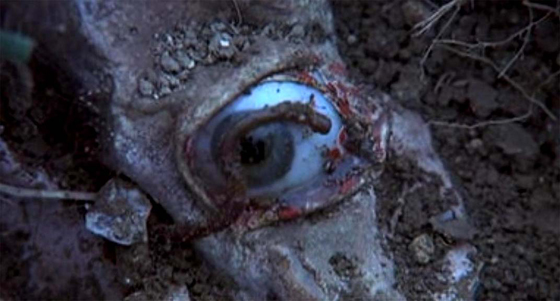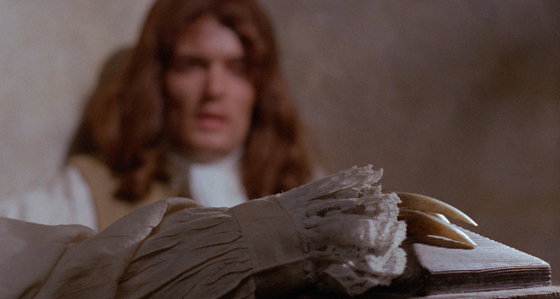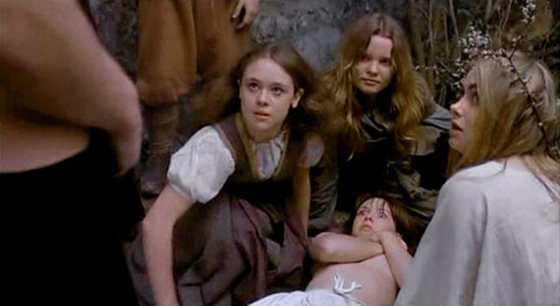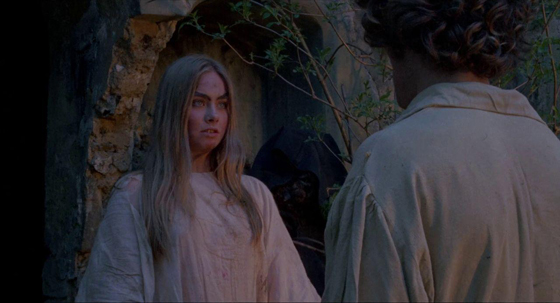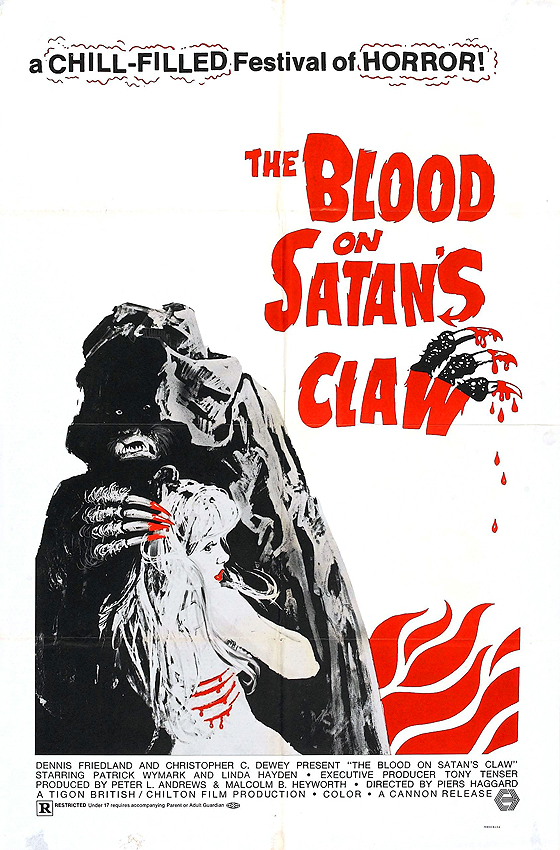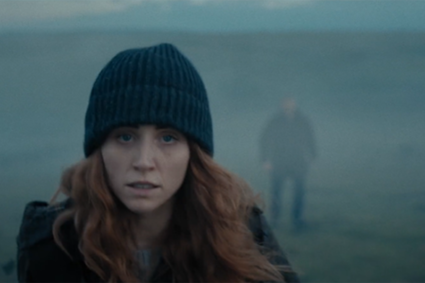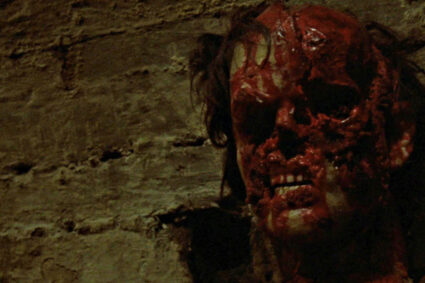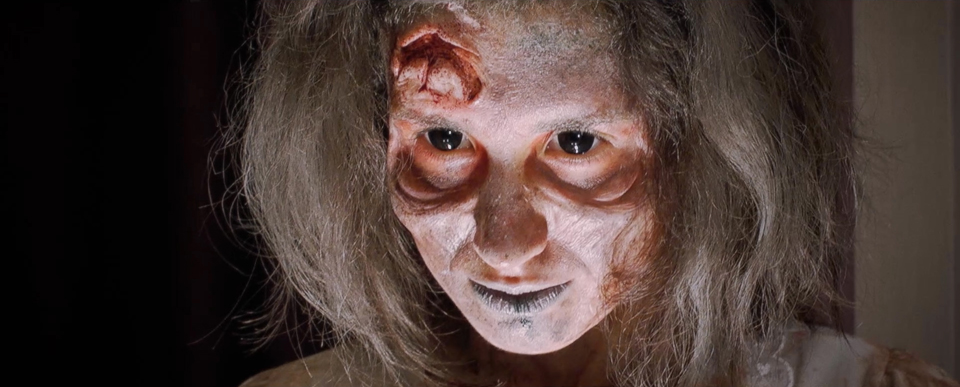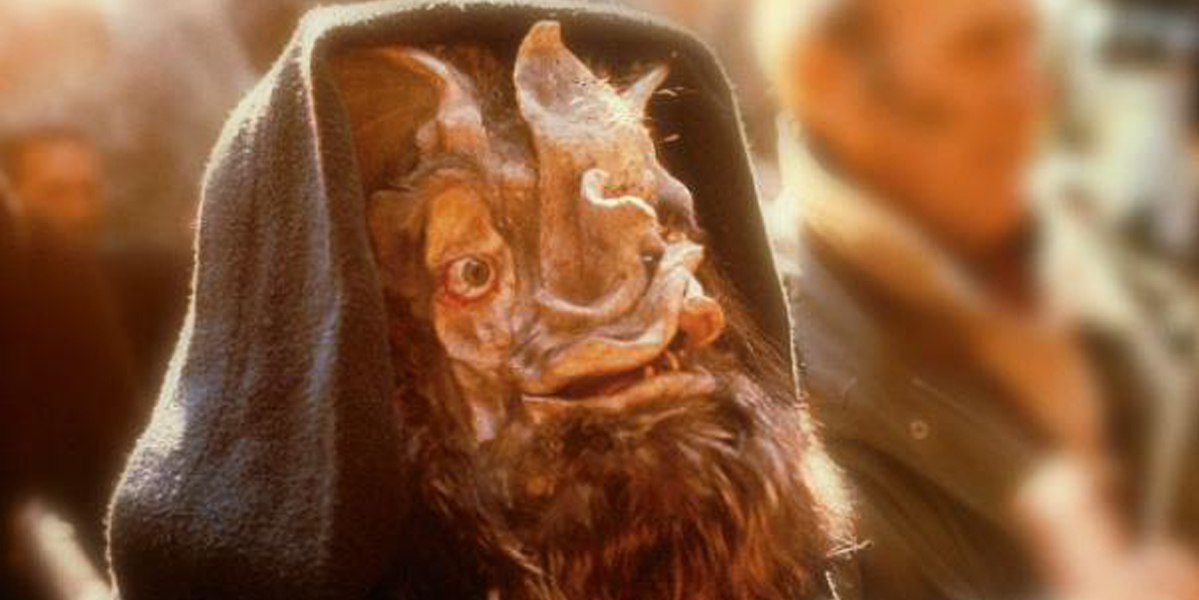
“How do we know, sir, what is dead? You come from the city. You cannot know the ways of the country.” –The Village Doctor, to the Judge.
I’ve heard it said that 1971 was perhaps the peak year for horror movies. There were certainly many great ones released in that tumultuous year, including The Abominable Dr. Phibes, Let’s Scare Jessica to Death, Dr. Jekyll and Sister Hyde, A Bay of Blood and many more. Period horror films were still the rage, and the first examples of a bloody new genre known as “giallo” were starting to emerge from Italy. And there were plenty of rotgut flicks like Al Adamson’s Dracula vs Frankenstein and T.V. Mikels’ The Corpse Grinders to keep the grindhouses humming.
Almost overlooked at the time was a low budget film from England’s tiny Tigon Films, provocatively titled The Blood on Satan’s Claw. Considered a failure at the time of its release, this eerie and atmospheric film has since risen to be considered one of the “unholy trinity” of movies that defined the folk horror genre. The other two were Michael Reeves’ Witchfinder General (aka Conqueror Worm) and The Wicker Man. Both of those films have since been regarded as classics of horror and rightly so. But in my mind, The Blood on Satan’s Claw is just as potent and full of subtext and hidden meanings.
Tigon Films, helmed by Tony Tenser, was often considered a knock-off of Hammer and it can’t be denied that there is a lot of resemblance. Yet the very best Tigon films, such as The Creeping Flesh, Witchfinder General, The Sorcerers, and, of course, The Blood on Satan’s Claw had their own special mood, which in many cases went further and deeper into uneasy atmosphere than Hammer did. I’d love to dive into the entire Tigon milieu, but such an article would be way beyond our scope here.
In the early ‘70s, Satanism and the occult ran rampant at movie houses. The Devil was big business. And society was also reeling from the Manson murders and the specter of peaceful hippies turned demented killers. The Blood on Satan’s Claw taps deeply into these topics but translates them to the rural English countryside of the early 1700s. And it does so with brilliance.
The movie was directed by Piers Haggard and can be considered his best work. Many movies are set in the historical past but are never convincing in their detail. Somehow, Haggard was able to recreate the beauty and ominous mystery of rustic 18th century Britain so well that it feels as if we are looking through a window at the real thing. The sets, costumes and period detail are perfectly done…the speech of the film’s characters is archaic, with “thees”, “thous” and the like. Nothing here is modernized, and everything sounds “right”, including the music, which is haunting and eerie.
The movie begins with the upturned earth of a farm field and remains steadfastly rural throughout its length. The character of The Judge is the only example of “the city” and rational, scientific thought. The pagan past of Britain remains locked in the fertile soil, ready to be dug up and unleashed on its simple farm folk. The youth of the village quickly succumb to the evil temptations of the past…but there are also honest, hard-working, God-fearing folk to stand up to that evil.
Come with me now, to the fields of Old Britain, and be warned, spoilers are ahead ….
We begin immediately with a field somewhere in rural England. It’s never specified exactly where, and we never hear the name of the village where the action takes place. Young Ralph Gower (Barry Andrews) is plowing the furrows in a back-breaking old-fashioned method. In a beautiful bit of foreshadowing, we see a clutch of white doves pecking at something buried in the dirt … white doves and one black crow. Ralph stops his plowing to see what the obstruction ahead of him is … and is aghast to discover it is the misshapen skull of some strange creature not entirely a man and not completely a beast. To make things extra creepy, an eye stares at him from the skull, with a worm crawling right across it.
This unwelcome discovery brings a nightmare of satanic possession to the rural backwater. The film’s excellent and unforgettable theme music eerily plays during the opening credits. It’s an integral part of the movie’s mood and focuses on two major themes. One is a creepy piping, almost tittering motif while the other is a lush movement with a melody that recalls the rustic past. Marc Wilkinson should get full marks for coming up with the music.
Ralph excitedly runs to the nearby estate of Lady Banham, who is being visited by her friend, a Judge from London. The Judge is played by Patrick Wymark, and he emerges as the sole representative of hard-headed and rational city life. This was Wymark’s last role, as he passed away just weeks after the film was completed. The role was originally offered to Peter Cushing, who turned it down due to the recent death of his wife.
When Ralph tells Lady Banham and the Judge that he has found “a fiend” in the furrows, a skeptical Judge goes out to take a look. When the men return to the spot, the deformed skull is now gone, and a patronizing Judge tells Ralph he must have imagined it. He will soon find out how wrong he was.
Nearby, the teenaged youth of the village, led by beautiful young Angel Blake (Linda Hayden), are playing and cavorting….
Meanwhile, young Peter Edmonton (Simon Williams) introduces his young fiancée Rosalind to his aunt Lady Banham and the Judge. Rosalind, a shy village girl, is belittled as being far beneath Peter’s station and she is driven almost to tears by Lady Banham. She is separated from Peter and forced to spend the night in the estate’s attic room, empty and unused since the death of Lady Banham’s husband.
Rosalind’s experience in the room is a dreadful one. Something we can’t see visits her and she begins screaming like a banshee. When the Judge and Lady Banham investigate, Rosalind attacks the Lady and puts up a fierce fight. The Judge summons other servants and Rosalind is barricaded in the attic room despite the protests of an impotent Peter. The Judge says he will reopen the room in the morning and have Rosalind taken to the asylum for treatment. When morning comes and the room is opened, a quiet Rosalind is removed. When Peter tries to speak to her, she smiles vacantly and shows no sign of recognizing him. She has been driven mad by whatever she has experienced.
As Rosalind is carted off to the asylum, Peter is horrified to see one of her hands peek from the cloak she’s wrapped in … it looks like the hairy claw of a monstrous beast.
Evil has come to the nameless village.
The village teacher, devout Reverend Fallowfield (Anthony Ainley, who ironically played Dr. Who’s deadly nemesis The Master), discovers that several of the children in his charge are truant, and the others try to hide a bag from him … containing claws like what Peter saw on Rosalind’s hand! The students are strangely insolent and mocking.
Peter is determined to find out what happened to Rosalind and sneaks into the attic room to spend the night. Before long, an unseen presence arrives and a clawed, hairy paw attacks Peter in bed. During the struggle, Peter finds his knife, hacks at the paw, and lets out a bloodcurdling scream. The Judge breaks into the room and finds Peter alone, sobbing on the bed. On the mattress is his own severed hand….
When morning arrives, Mistress Banham, struck ill after Rosalind’s ordeal, has vanished, and is not found after a thorough search. The Judge, once skeptical of supernatural events, is now reconsidering his position. The wise village doctor shows him an ancient book. A picture in the book depicts a distorted fiend that looks like what Ralph Gower found in the fields.
Related Content:
Hammer’s Forgotten Horrors: John Gilling’s Three Horror Classics from the 1960s
Remembering Sir Christopher Lee
The Judge makes the decision to take the book and leave for London, saying he will return. When the pompous town mayor complains that he is needed more in the village, the Judge tells him that evil must be drawn out in the open and exposed before he can destroy it. One gets the impression that The Judge is a cold-hearted man who is not particularly concerned with the fate of country folk.
While the Judge is gone, the village youth turn from mockery to murder. Young Mark Vespers, son of Lady Banham’s good-hearted maid Ellen, discovers a strange patch of fur on his body. His young mates lure him to a ruined church, where Angel Blake seems to be the high priestess of a sinister cult. Mark is tricked into a deadly game of blind man’s bluff … his body is later found by his mother in a woodpile.
A sensuous Angel attempts to seduce Rev. Fallowfield, removing her clothes in front of the priest in a highly erotic scene reminiscent of the scene in The Wicker Man where a nude Britt Ekland tries to entice Edward Woodward’s character. Somehow, the Reverend summons the strength to resist the wicked girl. Enraged, Angel calls the priest a “dirty old pagan” and says she and her friends have “cut the devil out” of Mark.
Following Angel’s whispers and innuendo, the mayor arrests the priest for Mark’s murder. Meanwhile, Mark’s sister Cathy (Wendy Padbury), who is Ralph Gower’s sweetheart, is gathering flowers for Mark’s funeral when young boys trick her into playing a game, inevitably tying her up with a rope. She is led to the old church, where Angel’s coven is gathered. But something else is also there, a crouching figure in a black robe that looks misshapen and distorted. The devil of the fields is abroad in the land!
The next scene is very hard to watch, even today. Cathy is placed under a spell and forced to disrobe as a pagan ritual ensues and a prayer to the demon Behemoth is read. We notice Cathy also has a patch of fur on her back. She is brutally raped by one of the boys and later stabbed by Angel, who cuts the fur patch off her body. This scene is some extremely uncomfortable viewing even though the sex and gore is actually fairly subdued. There is something about seeing kids involved in Satanic sex rituals that is unnerving. Adding to that feeling is the fact that Wendy Padbury was famous as one of Dr. Who’s cheerful companions. In later years, director Haggard admitted that he went too far with this rape scene.
Ralph, who heard Cathy’s dying scream, finds her body in the ruins of the old church. Heartbroken, he brings her body to the mayor and tells him Angel is responsible. Fallowfield is immediately released, and the men of the village gather. Witches are among them and must be hunted down.
Ralph encounters men from the village chasing after the young girl Margaret (Michelle Dotrice) who is part of the coven. They capture her and throw her into the river, believing that if she floats, she must be a witch. She sinks like a stone. Now it must be admitted that even though this is a grim scene, you will immediately be reminded of the skit from Monty Python and the Holy Grail where the witch is compared to a duck. I’m surprised the villagers didn’t try to make a bridge out of Margaret.
Ralph comes to Margaret’s rescue and saves her from drowning. He brings her back to Ellen, who pledges to nurse her back to health and raise her as if she were her departed daughter Cathy. But Margaret is having none of it…she is a devoted servant of Behemoth and mocks her rescuers. The village doctor discovers a patch of strange fur on her leg and decides to cut if off her, which sends Margaret into a panic. She is sedated and the offending skin is removed and put in a bottle.
Meanwhile, the Judge has returned from London, accompanied by a pack of vicious dogs and a bald, mute brute of a man. Sharp eyed viewers will recognize this fellow as Milton Reid, who played a thug in many horror and action movies of the period. He also is bearing a mysterious package.
When Margaret escapes from Ellen and flees into the woods, the Judge sets his dogs to track the girl at once. It isn’t long before Margaret is again captured and sternly interrogated by the Judge, who again proves to be a cold, relentless man. Under heavy pressure, Margaret reveals that Angel and her coven are hiding at the ruined church. They are using pieces of their contaminated bodies to rebuild the demon Behemoth in its entirety … only a few more pieces are required before he reaches his full power.
That’s all the Judge needs to hear. He assembles a posse of maddened villagers to join him … he intends to wipe out the cult and kill the demon. Meanwhile, it’s revealed that Ralph himself will be the final victim of the coven … he has sprouted fur on his leg and has also been kidnapped by the cult.
A full-blown ritual is going down at the ruined church, with Angel and Behemoth presiding. The devil’s skin will soon be cut from a helpless Ralph. But with the baying of hounds, the witch hunters have arrived and surround the cult. They fall ruthlessly upon the coven, many of whom I would think are their own children. Angel is killed by a pitchfork and the Judge reveals what is within the mysterious package … a holy sword blessed by the archbishop. He encounters Behemoth face to face and with pure determination impales the monster upon the sword, tossing the body into a bonfire where it explodes.
Ralph notices with relief that his leg has returned to normal. The curse of the demon has ended but the cost has been high, and the village will never be the same.
The ending seems rushed and abrupt and indeed, it was a last-minute change to the original ending. The first draft of the story simply had the Judge killing everybody in the village. But Haggard determined this was too bleak and shot the slightly more hopeful conclusion. Although, the fanatical look in the Judge’s eyes at the end seems to give the promise of further violence….
The greatest difference between The Blood on Satan’s Claw and the other two members of the “unholy trinity”, The Wicker Man and Witchfinder General, is that the Devil is 100% REAL here. Witchfinder General goes out of its way to show the true monsters are the witch-hunters and that there is no such thing as witchcraft. Wicker Man also takes a rationalist approach, but in that film, the pagan coven is real and a deadly danger to unbelievers. With The Blood on Satan’s Claw, we see in the very first minute of the film that the Devil is real when Ralph finds the monstrous skull in the fields. In that sense, the Judge’s merciless approach is totally justified, because we see the evil spawned by Behemoth.
The film’s approach to women is multi-faceted and one of its most interesting aspects. We see every type of female archetype throughout the film. Poor Rosalind is a shy village girl who dares to love above her station. Her reward is not only ostracism from her “betters”, but a lifetime of madness when the demon confronts her. Lady Banham represents the “upper crust” and is an old maid whose years of fertility are behind her. We never really learn what happened to her, but I suspect Behemoth used most of her body to manifest himself. Ellen is a true mother who is full of compassion and love, even when both of her children are murdered by the cult. Daughter Cathy is the very image of the pure young virgin who is savagely killed because of that purity. I get the impression that pure souls like Cathy and Ralph cannot be converted to the coven, so they must be killed.
Of course, the absolute opposite of Ellen and Cathy in every way is the sensuous and ironically named Angel Blake. As played by 17-year-old Linda Hayden, Angel is every bit the embodiment of the pagan priestess of sex and fertility. She revels in her role, and we see that she’s bitterly disappointed when she can’t get the godly Reverend Fallowfield to give in to her seduction. In cult movie circles, Angel Blake has become something of an archetypal character too. She can also be considered the “Manson” figure who leads her flock to murder.
The real heroes of the movie are Ralph and Ellen. They represent the good side of British country folk, with pure and honest hearts. Despite his part in destroying the cult, The Judge is definitely NOT a hero, and he never really acts like one. Originally a pure rationalist, he becomes a fanatic witch killer along the lines of Matthew Hopkins once he sees the Devil is real. He’s very much an Oliver Cromwell type of character and Patrick Wymark is perfectly cast in the role. As brilliant an actor as he is, I don’t think Peter Cushing would have been as convincing.
Despite the rushed feeling of the ending, The Blood on Satan’s Claw is a satisfyingly compelling example of both folk horror and historical film. You will never see a movie that looks more like rural Britain of the early 18th century. It is still disturbing and entertaining in equal measure.


